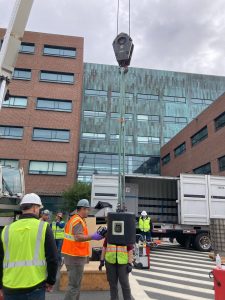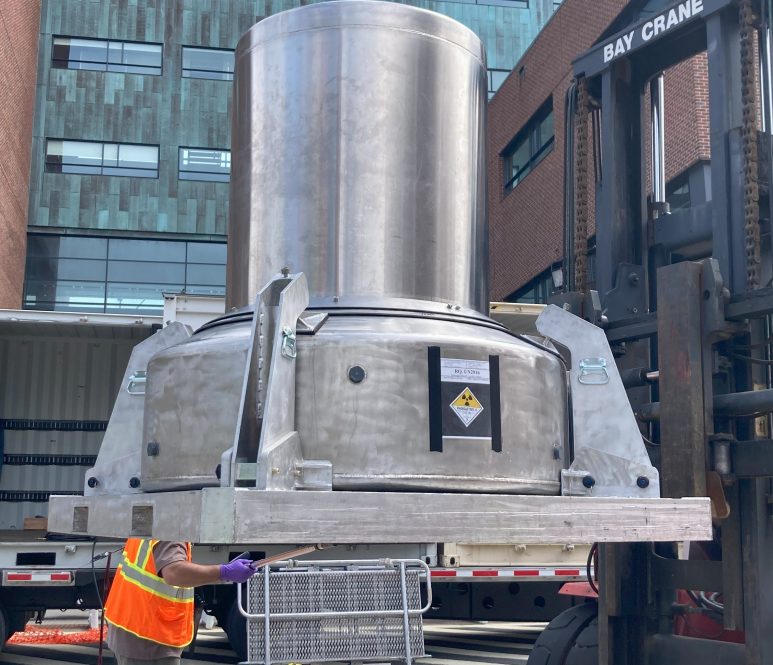In a milestone move intended to increase campus safety and lower operational costs, safety officials at UConn Storrs and UConn Health recently coordinated the removal of four cesium-sourced irradiators used for research and medical purposes.
The disposal operation – a costly, highly-choreographed effort at each site that involved cranes, giant disposal casks, flatbed trucks, and campus and state police escorts – was made possible through the Cesium Irradiator Replacement Project (CIRP), a voluntary initiative of the U.S. Department of Energy (DOE) offering financial incentives to medical and research institutions willing to replace cesium-137 irradiators with new x-ray-based devices. Run by DOE’s National Nuclear Security Administration (NNSA), Office of Radiological Security (ORS), the program covers 100% of the cost of disposing cesium-137 based irradiators and reimburses up to 50% of the purchase price of new equipment.
Kevin Higgins, the radiation safety officer at UConn Health, estimates it would have cost roughly $580,000 each – a total of $1.74 million – had UCH attempted to dispose its three irradiators on its own. Another $450,000 to $500,000 in savings was realized, he says, thanks to CIRP covering half the cost of two new X-ray irradiators that replaced the two cesium-based devices used by researchers and the blood bank at UCH. A third cesium irradiator no longer in use, was removed but not replaced.
At Storrs CIRP helped offset roughly $882,000 in costs associated with the removal and replacement of its single cesium-sourced irradiator, a 1969-era model housed in the Pharmacy Biology Building and used for genetics and cell research, says Amy Courchesne, the radiation safety officer at UConn Storrs. The program also reimbursed the cost of add-ons for the new X-ray irradiator, which included specialized accessories, and $16,000 for modifications to the room it occupies, and a service contract.
“If we decided not to go with CIRP, the University would have had to cover those costs,” she says.
The primary goal of CIRP is to reduce the security risks associated with the institutional use of cesium-137 and cobalt-60 sourced irradiators. The irradiators are safely shielded to protect users from exposure but contain highly radioactive isotopes with a long half-life that could pose a significant health risk if dismantled from their protective shielding or released into the environment.
While radioactive source irradiators have benefits, such as scientific research and the irradiation of blood, they would pose a grave risk to communities should they be lost or stolen. In the wrong hands, even a small amount of high-activity radioactive material could be used in an act of radiological terrorism.

UConn is among the hundreds of academic, medical, and other institutions to participate in CIRP since its inception in 2014. In course of 10 years, the program has facilitated the replacement of 67% of the radio-isotopic irradiators in the United States, according to Evan Thompson, a foreign affairs specialist with NNSA.
As of Sept. 5, 2024, some 235 cesium-137-sourced blood irradiators have been replaced through the program and 82% of self-shielded cesium-137-based blood irradiators in the U.S. have been replaced, removed, or are slated for removal by contract or pledge.
Replacing the irradiators at both sites required a great deal of planning, teamwork, and coordination. At UCH, the new research irradiator was installed prior to the cesium irradiator being removed. For the blood bank, an entirely new location for blood irradiation was constructed.
On removal day, UConn, state, and local police were onsite to secure the site and manage traffic flow. The irradiators were then disassembled to access the shielded containers housing the radioactive sources. The containers, which weigh several thousand pounds, were then moved under police escort to a loading dock, lifted from there to a loading dock and placed on the ground. A crane then hoisted them up and into a specially designed shipping cask securely fastened to the flatbed tractor-trailer. As a last step, the cask was pressure tested to ensure proper assembly and escorted offsite by state and local police.
The advantages of participating in the program go well beyond the cost savings associated with removal and replacement, notes Courchesne. The bureaucratic and regulatory aspects of operating the cesium-sourced irradiators were significant.
“Due to security, FBI background checks were required for unescorted access,” she says. “After 9/11, the Nuclear Regulatory Commission put additional security orders into effect, including 24/7 monitoring, fail-safe monitoring with backup power, contingency planning and more.”
The stricter rules prohibited the university from publicly disclosing that it owned a cesium-sourced irradiator, which limited use of the device to researchers within the university. Individuals interested in using the irradiator for research had to contact Courchesne and take an exam to ensure they had the capability to safely use it, then be escorted by radiation safety personnel when they used it.
Under CIRP, the cradle-to-grave custodianship of the cesium-sourced devices shifts from the owning institution to the federal government, freeing UConn and UCH from that responsibility and any associated costs.
At Storrs, the removal was facilitated by UConn’s Office of Vice President for Research (OVPR). Jeremy Balsbaugh, director of UConn’s Center of Open Research Resources (COR²E), will oversee the installation and the new X-ray irradiator at that site and its future use by researchers.
“As the radiation safety officer, I’m excited that researchers will be able to use the replacement X-ray irradiator,” says Courchesne. “We can share about it and promote collaboration. We don’t have the liability and regulatory restrictions around the device anymore.”



